VVAM Newsletter 93 – 2004
From the editors
As you can see, and as announced in the invitation to the AGM sent to you in early March, we have a ‘new look’ Newsletter. The new design is the work of Michel Hildebrand from Wageningen. In recent years he has also produced the dust jacket and lay¬out designs for various publications about the Battle of Arnhem, such as ‘B Company Arrived’ and ‘By Land, Sea and Air’. Among the other design work Michel does for the Airborne Museum are the exhib¬ition posters and the covers for video and DVD boxes.
Unfortunately, the preparations for the Newsletter facelift and the modernising of the production process cost more time than predicted, partly due to a number of technical problems and to the totally unexpected bankruptcy of our ‘home print works’ in Oosterbeek. All this combined to delay the appear¬ance of the first, revitalised issue.
Many memorable events will be taking place this year, the 60th anniversary of the Battle of Arnhem. We hope to keep you right up to date with regular reports in the Newsletter.
In response to reactions from the membership it has been decided that, from now on, the Newsletter will be sent unfolded in A4 envelopes.
New board member
During the 24th AGM/General Members Meeting of the Society of Friends of the Airborne Museum held in the Concert Hall in Oosterbeek on Saturday 24 April last, Mr Ivar R.M. Goedings was elected to the management board. Thirty-five year-old Mr Goedings was bom in Oosterbeek and is a lawyer in Ede. He has been interested in military history for many years and it almost goes without saying that, from an early age, his special interest has been the Battle of Arnhem, on which subject he has a comprehensive library. His other interests include the struggle on the Western Front during World War I, and he therefore makes regular visits to Ypres and the Somme area.
We Will Remember Them, 1944-2004’
On 21 April 2004, Drs.J.C. vanWaveren, Councillor for Open Space and Monuments for Renkum Munici¬pality, opened the ‘We Will Remember Them, 1944- 2004’ exhibition in the Airborne Museum. The exhi¬bition gives a picture of all aspects of the commem¬orations of the Battle of Arnhem that have taken place over the last sixty years. Subjects include the annual ‘Pilgrimages’, the service at the Airborne Cemetery, the raising of monuments, the issuing of special souvenirs such as commemorative coins, plates and envelopes, the Airborne Walk and many more items. The majority of photos and other objects in the exhibition come from the museum’s collection, but a number are on loan from private collections.
The exhibition continues until 1 November this year.
‘Theirs is the Glory’ now also available on DVD
The film ‘Theirs is the Glory’ has recently become available on DVD. A large part of the film was shot in the ruins of Arnhem and Oosterbeek in August and September 1945. British servicemen, who them¬selves fought in the Battle of Arnhem the year before, played the roles, not professional actors, and the film was premiered on 17 September 1946. A few years ago ‘Theirs is the Glory’ appeared on video. The recently produced DVD is for sale only in the Airborne Museum ‘Hartenstein’, price € 32,50.
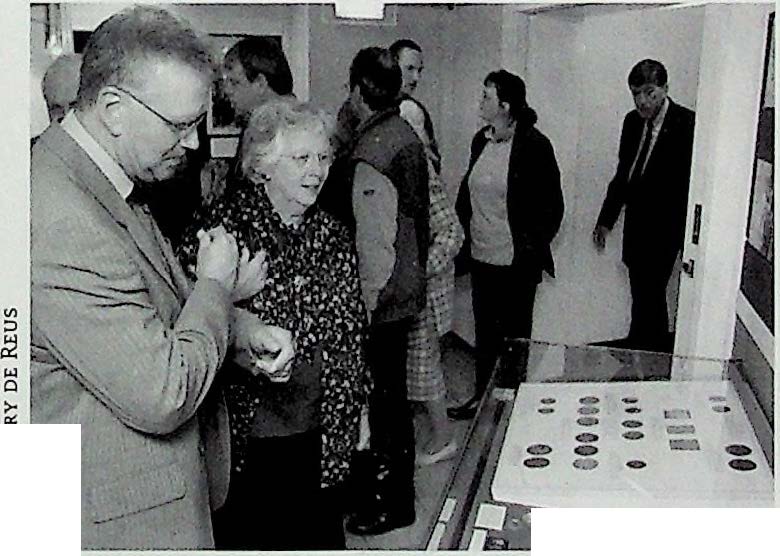
21 April 2004. At the opening of the ‘We Will Remember Them’ exhibition, Renkum Burgomaster Bruinooge and Mrs Van Slooten, wife of the Airborne Museum Foundation chairman Mr. J. van Slooten, inspect the com-memorative coin display cabinet.
News from Niall
A short time ago a number of British members of the Friends’ Society contacted me about an item they had seen offered for sale on the Ebay internet auction site. Apparently, it was a battledress blouse that had allegedly belonged to Colonel Graeme Warrack, Divisional Chief Doctor of the British 1st Airborne Division in September 1944.
The sellers had placed a reserve price of £ 700 on the blouse. In the advertisement the distinctive features of the jacket were described in detail, and included parachute wings and the initials ‘GW’ on a small label stitched to an inside pocket. Among the medal ribbons mentioned were the MBE and the Military Cross. The advert closed with a short summary of his experiences.
After reading the advertisement alarm bells began to ring. I got in touch with the Curator of the Army Medical Services Museum, Captain Peter Starling, – also a Friends’ Society member – and together we came to the conclusion that Warrack had never won a Military Cross, had never been awarded an MBE, and had never undergone parachute training. I wrote to the sellers expressing my doubts about the originality of the uniform blouse, but they insisted it was genuine. Nevertheless, they removed it from the Ebay site and then offered it for sale on their own website, now at a minimum price of ? 1000!
I would never make an offer for such an item but the lesson is clear for us all: potential buyers beware! It would seem that there are people who manufacture ‘Arnhem’ artefacts themselves in the hope of ripping off the unsuspecting for lots of money.
(Niall Cherry)
Social Evening well attended
On Friday evening 13 February the Friends’ Society held the latest in a series of Social Evenings in the Airborne Museum. Non-members were also wel¬come this time so that they could become acquaint¬ed with one of the society’s activities. Entrance to the museum was free for the non-members, too, as well as the coffee! Aad Groeneweg and Robert Sigmond had opened the library and archives and were available all evening to answer questions. More than 65 people availed themselves of this opportun¬ity. In the area reserved for temporary exhibitions, Roland Boekhorst displayed a large number of objects which have recently been excavated on the ‘De Schuytgraaf building site. This site lies between Driel village and the Arnhem-Nijmegen railway line and was used as a dropping zone by the 1st Polish Independent Parachute Brigade Group on 21 September 1944. Over the months that followed, units of the 101st U.S. Airborne Division and various British army units fought in that area. Many wartime relics were discovered while the ground was being prepared for building work. Using examples, Roland explained how the material is cleaned, preserved and registered.
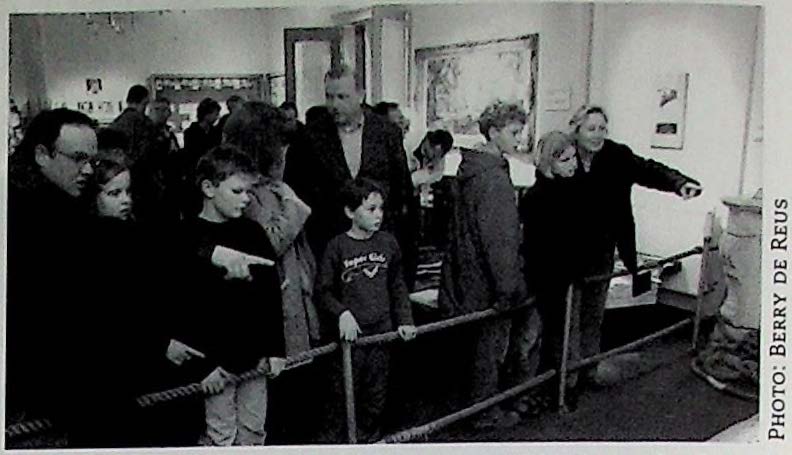
Social Evening, 13 February 2004. With the aid of the scale model in the Airborne Museum, parents point out to their children the places that played an important part in the Battle of Arnhem. In the centre is our society chair¬man, Ben Kolster
Hans van der Velden brought along a substantial selection of emergency rations (in various packag¬ing) from his collection and Ron van Slobbe exhibited material about the Arnhem Rhine Bridge and surroundings. A pleasant incident occurred during the evening when a visitor arrived with a pair of large, well-preserved German military binoculars which he gave to the museum! A lovely acquisition. On the whole the evening was a great success, but next time we hope that more society members will be prepared to exhibit items from their collection or results of research. Undoubtedly there are more than just two members who have material or docu¬ments that would be of interest to others. One can already put one’s name forward, without obligation, to Eugene Wijnhoud for the next Social Evening.
(W. Boersma)
Gift from the Chaplains Museum in Andover
In November 2000 the book ‘The Torn Horizon, The Airborne Chaplains at Arnhem’ by Chris van Roekel was published. Of course a copy was sent to the Chaplains Museum in Andover, England. At the same time Chris asked if the museum might have uniforms or equipment, as worn by the chaplains in World War II, for our museum. A long-cherished wish has been to place a figure in the aid post dio¬rama representing the Reverend A.H.W. Harlow. Harlow was attached to divisional HQ, and during the Battle of Arnhem he assisted Dr. Randall in car¬ing for the wounded in the Hartenstein cellar.
In reply, the Chaplains Museum staff promised var¬ious items, but the museum had not then been opened to the public and the exhibits were still in their packing cases. However, early in December 2003 Chris received a parcel from Andover for the Airborne Museum. The contents included specific articles of clothing and badges of a chaplain plus items required for field services such as a silver chalice and hip flask for the communion wine, and a small wooden box for carrying the communion wafers. Everything is marked with the well-known British broad arrow and the year ‘1944’, even the wooden host box. It is a generous gift from the Chaplains Museum and very much appreciated by everyone at the Airborne Museum. In the course of next year a mannequin representing an army padre will be placed in the aid post diorama.
Wreck of a German aircraft recovered
In an ‘operation’ lasting from 4 till 8 April last, the remnants of a German single-engined fighter aircraft were recovered by an eight man unit from the Royal Dutch Navy’s diving and dismantling team. The aircraft, a Focke Wulf 190, crashed into the river Rhine just west of the railway bridge in Oosterbeek, probably some time in late September/ early October 1944. Parts of the machine were exposed during last year’s hot summer when the water level was extremely low. The decision was taken to recover the wreck because it was in a recre¬ation area, and for all anyone knew there might be explosives on board, perhaps even a bomb.
No bomb was found during excavations even though a search was made to a depth of six metres. However, some human remains were found, as well as about 25 kilos of ammunition. Among the remnants of the recovered aircraft were cockpit com¬ponents such as an oxygen mask and some instru¬ments. The propeller was also found.
Sadly, the bone fragments were insufficient to allow a positive identification of the pilot to be made, so these will be laid to rest in the German war cem¬etery in Ysselsteyn as ‘Unknown’. The Bomb Disposal Squad of the Royal Dutch Army took the ammunition to a safe location where it was destroyed. The excavated aircraft parts were taken to the Deelen Airfield Museum at Arnhem.
Society member Han Kardol possibly saw the crash of the aircraft in question. Although ordered by the Germans to leave the area, the Kardol family was still living in the house in Paasberg (Oosterbeek) from the end of the battle on 26 September 1944 until 4 October. Han, then nine years old, recalls that one day during that period, around noon, he saw an aircraft trailing smoke crash into the Rhine just west of the railway bridge.
A German naval photograph
Some years ago a series of, until then unknown, photographs from the Battle of Arnhem were ‘discovered’ in the Bundesarchiv in Koblenz. Appar¬ently, a German naval photographer had taken photos in the Dreyenseweg and Amsterdamseweg area of Oosterbeek / Arnhem. Around 20 September 1944 he shot two complete rolls of film. They included photos of German soldiers and vehicles, allied aircraft (Stirlings, Spitfires and Dakotas), a private car and supply containers. They are principally action photos but some scenes are posed.
A number of the prints show a German armoured vehicle. It belonged to the SS-Panzer-Aufklarungs- Abteilung 9, the reconnaissance unit of 9. SS- Panzer-Division ‘Hohenstaufen*. Ten Schiitzen- panzerwagen (SPWs) and other armoured vehicles from this unit were deployed in the surroundings of Oosterbeek. They fought there under the command of Kampfgruppe Spindler.
The photo reproduced here shows an Sd.Kfz. 250/3 ‘neu’ (new) on Dreyenseweg, on Wednesday the 20th. The machine gunner is firing his MG42 towards the northern part of Oosterbeek.
This ‘Sonderkraftfahrzeug’ gives a fine picture of the condition of most of the division’s vehicles. They were filthy dirty, not so much from mud and dust, more through oil and grease marks, with scratches, dilapidated caterpillar tracks, ordinary tyres and sometimes severe damage.
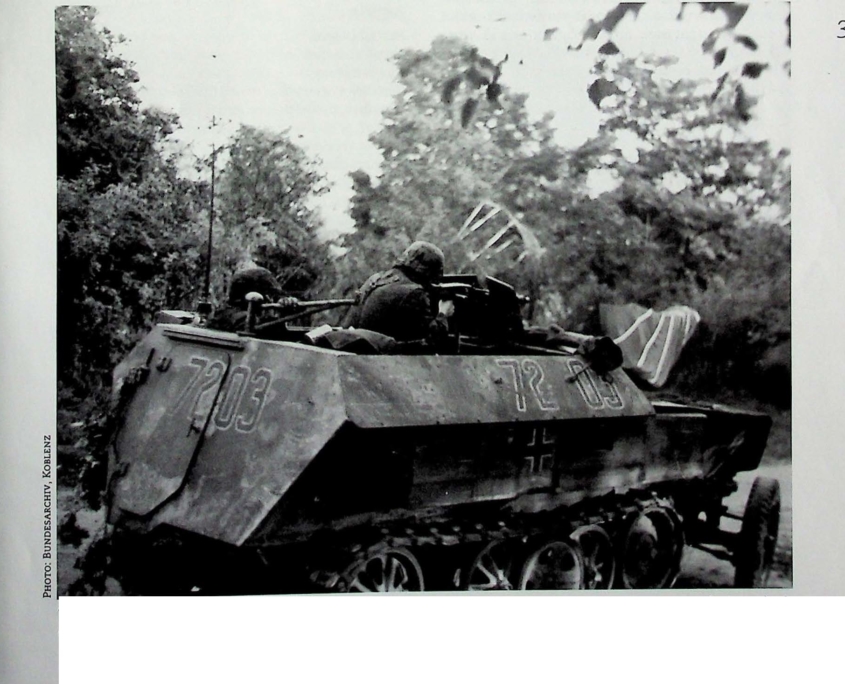
The German armoured vehicle photographed by German Navy war photographer Hoppner on Dreyenseweg in Oosterbeek on 20 September 1944. In the background are two British supply container parachutes.
For example, this SPW is still driving around despite the missing rear outer wheels. The front mudguards are also gone and, strangest of all, the rearmost sec¬tion of the right-hand supply chest has disappeared. The break line is so neat and tidy it almost looks as if the plate has been sawn off, and at first sight one doesn’t notice that it is missing.
The painted on number (7203) is probably black with white edging. The poor finish shows clearly that it was applied in a hurry. The camouflage pattern con¬sists of a dark yellow background with red-brown and green flecks. The camouflaging is reinforced by the multitude of oil and grease stains.
Despite the vehicle’s moderate condition it was a formidable opponent for the lightly-armed parachutists.
The photo described above has appeared in a num¬ber of books published in recent years, although, until now, the authors had no idea who the photog¬rapher was. However, via a private collection in Sweden we now know the details.
Thanks to the Arkiv Mirko Bayerl, we know what is written on the back of an original print: “Panzergrenadiere nach vorn!: Panzergrenadiere greifen im Panzerschiitzenwagen in einer schwierigen Situation gegen britische Fallschirmspringer ein.
PK/M L 5214 Wb
PK-Aufnahme: Kriegsberichter Hoppner”.
In other words: “Panzer grenadiers advance! In a dif¬ficult situation panzer grenadiers go into action against British parachutists.”
On 31 October 1944 the photo was released for pub¬lication by the German Propaganda Ministry. The abbreviation PK/M points to the fact that the photo¬grapher belonged to a Navy Propaganda Company. It is therefore clear that a certain Hoppner took photos of the combat actions concerned. Unfor¬tunately, nothing more is known about the man. It is known that he took more photos of the Battle of Arnhem than the two rolls in the Bundesarchiv. See, for instance, the book “Operation ‘Market Garden’ Then and Now” by Karel Margry (2002), which includes three photos attributed to Hoppner. The Koblenz archive number of the photo is 2KBK771/30. The first section indicates II Kriegs¬berichter Kompanie (Kriegsmarine) {2nd War Reporting Company (German Navy)). This could also indicate that there were at least two naval companies consisting of war reporters.
That is the story of one photo so far. The details in this article were compiled and arranged by Geert Maassen, with thanks to Marcel Zwarts, Bob Gerritsen, Karel Margry and Hans Timmerman. Anyone wishing to make additions and/or correc-tions is cordially invited to contact the compiler: Jan van Riebeeckweg 39, 6861 BD Oosterbeek (wamredactie@planet.nl)
Action
Last year eleven Dutch museums and organisations began an action on the internet aimed at preventing the disposing of material from the Second World War. They want to ensure that objects, photos and documents, whether in private hands or in the pos¬session of official bodies, do not end up in the waste bin by accident or design. Material sometimes seems unimportant, but this is not so according to the museums. Even now exceptional items are often discovered in attics and cellars, and it has happened that unique material has had to be rescued from the rubbish skip at the last minute. The action is called ‘Don’t throw it away’. Other organisations partici¬pating in the action include the Nederlands Instituut voor Oorlogsdocumentatie (NIOD) (Dutch Institute for War Documentation), the Jewish Museum and the Bronbeek Museum.
COLOPHON
The Newsletter is a publication of the Society of Friends of the Airborne Museum Oosterbeek (SFAM) and appears four times per year. The objective is to promote the Airborne Museum, the Society of Friends and the history of the Battle of Amhem.
Editors: drs. R.P.G.A. Voskuil and G.H. Maassen jr. Editorship address: Jan van Riebeeckweg 39, 6861 BD Oosterbeek; e-mail: wam@planet.nl Coordination sending, archiving and distribution of back numbers: Chris van Roekel, Oosterbeek.
English translation: Cathrien and Peter Clark.
Design: Hildebrand DTP, Wageningen.
Print: Drukkerij Verweij Wageningen BV.
Friends’ Society representative in the U.K.: Niall Cherry, 3 Church Road, Warton, Lancs PR4 1BD, tel. 01772 632764; e-mail: Niall.Cherry@bae.co.uk Airborne Museum ’Hartenstein’ address:
Utrechtseweg 232, 6862 AZ Oosterbeek, telephone 00 31 26 3337710;
e-mail: info@airbomemuseum.com
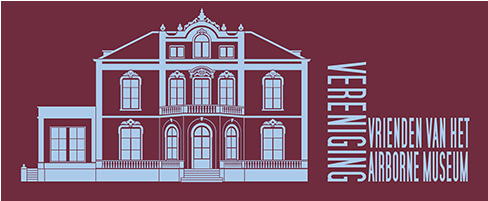
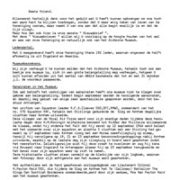
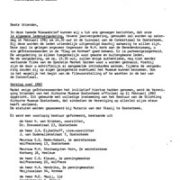
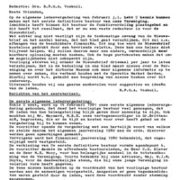
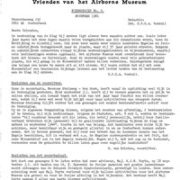
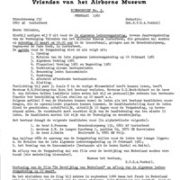
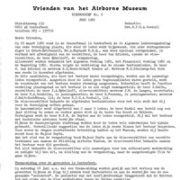
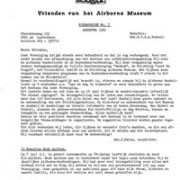
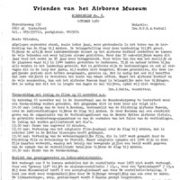
Plaats een Reactie
Vraag of reactie?Laat hier uw reactie achter.